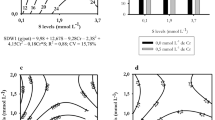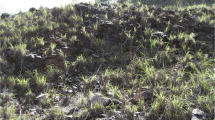Abstract
Given that Cd accumulates within plant tissues to levels that are toxic to animals, it is necessary to understand the role of plants in highly Cd-contaminated systems and their subsequent impact on the health of animals. A solution culture experiment was conducted to elucidate the effects of increasing Cd2+ activity ({Cd2+}) on growth of Rhodes grass (Chloris gayana Kunth.) and signal grass (Brachiaria decumbens Stapf.). The shoot and root fresh mass of both Rhodes grass and signal grass was reduced by 50% at ca. 0.5 µM {Cd2+}. Elevated {Cd2+} resulted in a significant decrease in the tissue Mn concentration for both the shoots and roots, and caused a chlorosis of the veins in the shoots. Root hair growth was prolific even at high {Cd2+}, thus root hair growth appeared to be less sensitive to elevated Cd than was root growth per se. The critical shoot tissue concentrations (50% reduction in growth), 230 µg g−1 for Rhodes grass and 80 µg g−1 for signal grass, exceeded the maximum level of Cd tolerated in the diet of animals (ca. 5 µg g−1). When assessing the risk associated with the revegetation of Cd-contaminated sites with Rhodes grass or signal grass, careful consideration must be given, therefore, to the transfer of toxic concentrations of Cd to grazing animals and through the wider food chain.




Similar content being viewed by others
Abbreviations
- EC:
-
electrical conductivity
- ICP-OES:
-
inductively coupled plasma-optical emission spectroscopy
- SEM:
-
scanning electron microscope
References
Ali NA, Bernal MP, Ater M (2004) Tolerance and bioaccumulation of cadmium by Phragmites australis grown in the presence of elevated concentrations of cadmium, copper, and zinc. Aquat Bot 80:163–176
Asher CJ, Edwards DG (1983) Modern solution culture techniques. In: Lauchli A, Bieleski RL (eds) Encyclopedia of plant physiology: inorganic plant nutrition. Springer-Verlag, New York, pp 94–119
Barceló J, Poschenrieder C, Cabot C (1985) Cadmium, manganese, iron, zinc and magnesium content of bean plants (Phaseolus vulgaris L.) in relation to the duration and the amount of cadmium supply. Z Pflanz Bodenkunde 148:278–288
Bowen HJM (1979) Soils. In: Bowen HJM (ed) Environmental chemistry of the elements. Academic, London, pp 49–62
Brady DJ, Edwards DG, Asher CJ, Blamey FPC (1993) Calcium amelioration of aluminium toxicity effects on root hair development in soybean (Glycine max (L.) Merr.). New Phytol 123:531–538
Cabrera D, Young S, Rowell D (1988) The toxicity of cadmium to barley plants as affected by complex formation with humic acid. Plant Soil 105:195–204
Cataldo DA, Garland TR, Wildung RE (1983) Cadmium uptake kinetics in intact soybean plants. Plant Physiol 73:844–848
Deifel KS, Kopittke PM, Menzies NW (2006) Growth response of various perennial grasses under saline conditions. J Plant Nutr 29:1573–1584
Dudka S, Miller WP (1999) Accumulation of potentially toxic elements in plants and their transfer to human food chain. J Environ Sci Health Part B Pestic Food Contam Agric Wastes 34:681–708
GenStat (2003) GenStat for windows. Release 7.2, 7th edn. VSN International, Oxford
Gillman GP, Bell LC (1978) Soil solution studies on weathered soils from tropical North Queensland. Aust J Soil Res 16:67–77
Godbold DL, Kettner C (1991) Lead influences root growth and mineral nutrition of Picea abies seedlings. J Plant Physiol 139:95–99
Hassan MJ, Shao GS, Zhang GP (2005) Influence of cadmium toxicity on growth and antioxidant enzyme activity in rice cultivars with different grain cadmium accumulation. J Plant Nutr 28:1259–1270
Hecht-Buchholz CH, Brady DJ, Asher CJ, Edwards DG (1990) Effects of low activities of aluminium on soybean (Glycine max). II. Root cell structure and root hair development. In: van Beusichem ML (ed) Plant nutrition—physiology and applications. Kluwer Academic, Dordrecht, pp 335–343
Kopittke PM, Menzies NW (2006) Effect of Cu toxicity on the growth of cowpea (Vigna unguiculata). Plant Soil 279:287–296
Kopittke PM, Asher CJ, Blamey FPC, Menzies NW (2007) Toxic effects of Pb2+ on the growth and mineral nutrition of signal grass (Brachiaria decumbens) and Rhodes grass (Chloris gayana). Plant Soil 300:127–136
Kopittke PM, Asher CJ, Blamey FPC, Menzies NW (2008a) Tolerance of two perennial grasses to toxic levels of Ni2+. Environ Chem 5:426–434
Kopittke PM, Asher CJ, Menzies NW (2008b) Prediction of Pb speciation in commonly used nutrient solutions. Environ Pollut 153:548–554
Kopittke PM, Asher CJ, Blamey FPC, Menzies NW (2009a) Toxic effects of excess Cu2+ on growth and mineral composition of Sabi grass (Urochloa mosambicensis). Sci Total Environ 407:4616–4621
Kopittke PM, Blamey FPC, Asher CJ, Menzies NW (2009b) Trace metal phytotoxicity in solution culture: a review.
Kovar JL, Barber SA (1988) Phosphorus supply characteristics of 33 soils as influenced by 7 rates of phosphorus addition. Soil Sci Soc Am J 52:160–165
Lock K, Van Eeckhout H, De Schamphelaere KAC, Criel P, Janssen CR (2007) Development of a biotic ligand model (BLM) predicting nickel toxicity to barley (Hordeum vulgare). Chemosphere 66:1346–1352
Mann SS, Rate AW, Gilkes AJ (2002) Cadmium accumulation in agricultural soils in Western Australia. Water Air Soil Pollut 141:281–297
Marschner H (1995) Mineral nutrition of higher plants. Academic, London, p 889
Martinie GD, Schilt AA (1976) Investigation of the wet oxidation efficiencies of perchloric acid mixtures. Anal Chem 48:70–74
McLaughlin MJ, Tiller KG, Hamblin A (1996) Managing cadmium in Australian agriculture. In fertilizers as a source of cadmium. Organisation for economic co-operation and development, Paris, France, pp 189–217
Menzies NW, Bell LC (1988) Evaluation of the influence of sample preparation and extraction technique on soil solution composition. Aust J Soil Res 26:451–464
National Research Council (U.S.) (2005) Mineral tolerance of animals. National Academy of Sciences, Washington, p 510
Parker DR, Norvell WA (1999) Advances in solution culture methods for plant mineral nutrition research. Adv Agron 65:151–213
Parker DR, Norvell WA, Chaney RL (1995) GEOCHEM-PC: A chemical speciation program for IBM and compatible personal computers. In: Loeppert RH, Schwab AP, Goldberg S (eds) Chemical equilibrium and reaction models. Soil Science Society of America and American Society of Agronomy, Madison, pp 253–269
Parkhurst D (2007) PhreeqcI v2.13.04. United states geological survey. http://water.usgs.gov/owq/software.html
Pinkerton A, Smith FW, Lewis DC (1997) Pasture species. In: Reuter DJ, Robinson JB (eds) Plant analysis: an interpretation manual. CSIRO, Collingwood, pp 287–346
Pinot F, Kreps SE, Bachelet M, Hainaut P, Bakonyi M, Polla BS (2000) Cadmium in the environment: sources, mechanisms of biotoxicity, and biomarkers. Rev Environ Health 15:299–323
Ramos I, Esteban E, Lucena JJ, Gárate A (2002) Cadmium uptake and subcellular distribution in plants of Lactuca sp. Cd-Mn interaction. Plant Sci 162:761–767
Reisenauer HM (1966) Mineral nutrients in soil solution. In: Altman PL, Dittmer DS (eds) Environmental Biology. Federation of American societies for experimental biology, Bethesda, pp 507–508
Sheldon AR, Menzies NW (2005) The effect of copper toxicity on the growth and root morphology of Rhodes grass (Chloris gayana Knuth.) in resin buffered solution culture. Plant Soil 278:341–349
Smolders E, McLaughlin MJ (1996) Effect of Cl on Cd uptake by Swiss chard in nutrient solutions. Plant Soil 179:57–64
Taylor GJ, Stadt KJ, Dale MRT (1991) Modeling the phytotoxicity of aluminum, cadmium, copper, manganese, nickel, and zinc using the Weibull frequency-distribution. Can J Bot 69:359–367
Wallace A, Romney EM, Alexander GV, Soufi SM, Patel PM (1977) Some interactions in plants among cadmium, other heavy metals and chelating agents. Agron J 69:18–20
Wenzl P, Patino GM, Chaves AL, Mayer JE, Rao IM (2001) The high level of aluminum resistance in signalgrass is not associated with known mechanisms of external aluminum detoxification in root apices. Plant Physiol 125:1473–1484
Wharton DA (1991) Freeze-substitution techniques for preparing nematodes for scanning electron microscopy. J Microsc (Oxford) 164:187–196
Wierzbicka M (1999) Comparison of lead tolerance in Allium cepa with other plant species. Environ Pollut 104:41–52
Wu FB, Wu HX, Zhang GP, Bachir DML (2004) Differences in growth and yield in response to cadmium toxicity in cotton genotypes. J Plant Nutr Soil Sc 167:85–90
Yang X, Baligar VC, Martens DC, Clark RB (1996) Cadmium effects on influx and transport of mineral nutrients in plant species. J Plant Nutr 19:643–656
Acknowledgments
The authors also thank Rosemary Kopittke for statistical assistance and Associate Professor Stephen Adkins for the use of the dissecting microscope. The assistance of the Rick Webb and Kim Sewell at the Centre for Microscopy and Microanalysis (UQ) with the electron microscopy is also acknowledged. This research was funded through CRC-CARE Project 3-3-01-05/6 and through The University of Queensland Early Career Researcher scheme (2008003392).
Author information
Authors and Affiliations
Corresponding author
Additional information
Responsible Editor Juan Barcelo.
Rights and permissions
About this article
Cite this article
Kopittke, P.M., Blamey, F.P.C. & Menzies, N.W. Toxicity of Cd to signal grass (Brachiaria decumbens Stapf.) and Rhodes grass (Chloris gayana Kunth.). Plant Soil 330, 515–523 (2010). https://doi.org/10.1007/s11104-009-0224-6
Received:
Accepted:
Published:
Issue Date:
DOI: https://doi.org/10.1007/s11104-009-0224-6




